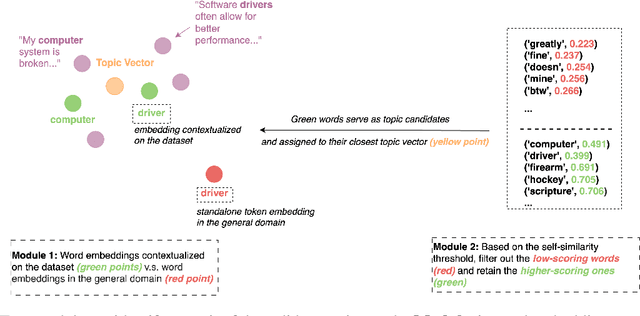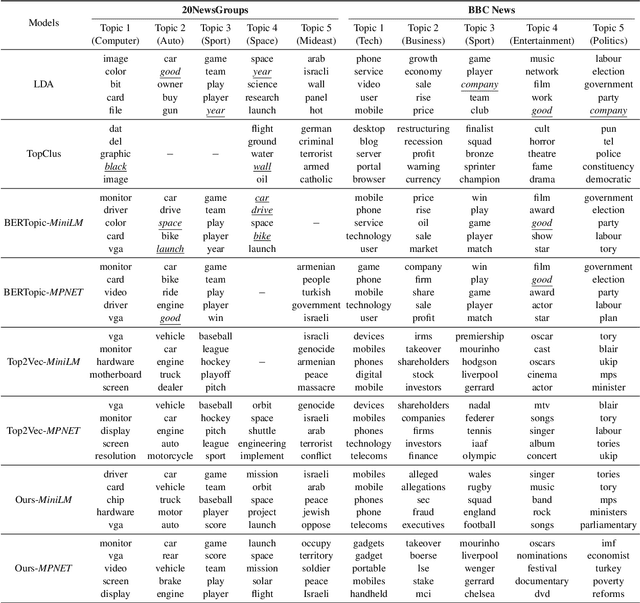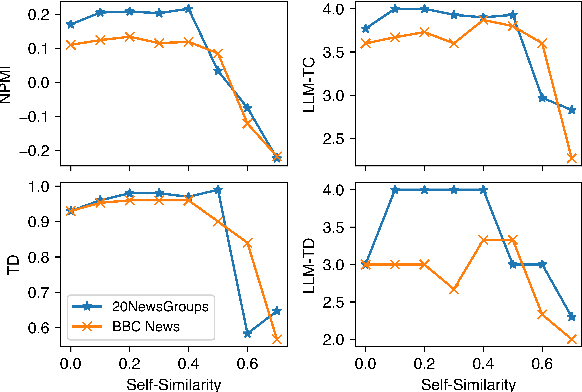Chenghao Xiao
MMTEB: Massive Multilingual Text Embedding Benchmark
Feb 19, 2025Abstract:Text embeddings are typically evaluated on a limited set of tasks, which are constrained by language, domain, and task diversity. To address these limitations and provide a more comprehensive evaluation, we introduce the Massive Multilingual Text Embedding Benchmark (MMTEB) - a large-scale, community-driven expansion of MTEB, covering over 500 quality-controlled evaluation tasks across 250+ languages. MMTEB includes a diverse set of challenging, novel tasks such as instruction following, long-document retrieval, and code retrieval, representing the largest multilingual collection of evaluation tasks for embedding models to date. Using this collection, we develop several highly multilingual benchmarks, which we use to evaluate a representative set of models. We find that while large language models (LLMs) with billions of parameters can achieve state-of-the-art performance on certain language subsets and task categories, the best-performing publicly available model is multilingual-e5-large-instruct with only 560 million parameters. To facilitate accessibility and reduce computational cost, we introduce a novel downsampling method based on inter-task correlation, ensuring a diverse selection while preserving relative model rankings. Furthermore, we optimize tasks such as retrieval by sampling hard negatives, creating smaller but effective splits. These optimizations allow us to introduce benchmarks that drastically reduce computational demands. For instance, our newly introduced zero-shot English benchmark maintains a ranking order similar to the full-scale version but at a fraction of the computational cost.
Everything is a Video: Unifying Modalities through Next-Frame Prediction
Nov 15, 2024Abstract:Multimodal learning, which involves integrating information from various modalities such as text, images, audio, and video, is pivotal for numerous complex tasks like visual question answering, cross-modal retrieval, and caption generation. Traditional approaches rely on modality-specific encoders and late fusion techniques, which can hinder scalability and flexibility when adapting to new tasks or modalities. To address these limitations, we introduce a novel framework that extends the concept of task reformulation beyond natural language processing (NLP) to multimodal learning. We propose to reformulate diverse multimodal tasks into a unified next-frame prediction problem, allowing a single model to handle different modalities without modality-specific components. This method treats all inputs and outputs as sequential frames in a video, enabling seamless integration of modalities and effective knowledge transfer across tasks. Our approach is evaluated on a range of tasks, including text-to-text, image-to-text, video-to-video, video-to-text, and audio-to-text, demonstrating the model's ability to generalize across modalities with minimal adaptation. We show that task reformulation can significantly simplify multimodal model design across various tasks, laying the groundwork for more generalized multimodal foundation models.
CAST: Corpus-Aware Self-similarity Enhanced Topic modelling
Oct 19, 2024



Abstract:Topic modelling is a pivotal unsupervised machine learning technique for extracting valuable insights from large document collections. Existing neural topic modelling methods often encode contextual information of documents, while ignoring contextual details of candidate centroid words, leading to the inaccurate selection of topic words due to the contextualization gap. In parallel, it is found that functional words are frequently selected over topical words. To address these limitations, we introduce CAST: Corpus-Aware Self-similarity Enhanced Topic modelling, a novel topic modelling method that builds upon candidate centroid word embeddings contextualized on the dataset, and a novel self-similarity-based method to filter out less meaningful tokens. Inspired by findings in contrastive learning that self-similarities of functional token embeddings in different contexts are much lower than topical tokens, we find self-similarity to be an effective metric to prevent functional words from acting as candidate topic words. Our approach significantly enhances the coherence and diversity of generated topics, as well as the topic model's ability to handle noisy data. Experiments on news benchmark datasets and one Twitter dataset demonstrate the method's superiority in generating coherent, diverse topics, and handling noisy data, outperforming strong baselines.
On the Rigour of Scientific Writing: Criteria, Analysis, and Insights
Oct 07, 2024Abstract:Rigour is crucial for scientific research as it ensures the reproducibility and validity of results and findings. Despite its importance, little work exists on modelling rigour computationally, and there is a lack of analysis on whether these criteria can effectively signal or measure the rigour of scientific papers in practice. In this paper, we introduce a bottom-up, data-driven framework to automatically identify and define rigour criteria and assess their relevance in scientific writing. Our framework includes rigour keyword extraction, detailed rigour definition generation, and salient criteria identification. Furthermore, our framework is domain-agnostic and can be tailored to the evaluation of scientific rigour for different areas, accommodating the distinct salient criteria across fields. We conducted comprehensive experiments based on datasets collected from two high impact venues for Machine Learning and NLP (i.e., ICLR and ACL) to demonstrate the effectiveness of our framework in modelling rigour. In addition, we analyse linguistic patterns of rigour, revealing that framing certainty is crucial for enhancing the perception of scientific rigour, while suggestion certainty and probability uncertainty diminish it.
BioMNER: A Dataset for Biomedical Method Entity Recognition
Jun 28, 2024Abstract:Named entity recognition (NER) stands as a fundamental and pivotal task within the realm of Natural Language Processing. Particularly within the domain of Biomedical Method NER, this task presents notable challenges, stemming from the continual influx of domain-specific terminologies in scholarly literature. Current research in Biomedical Method (BioMethod) NER suffers from a scarcity of resources, primarily attributed to the intricate nature of methodological concepts, which necessitate a profound understanding for precise delineation. In this study, we propose a novel dataset for biomedical method entity recognition, employing an automated BioMethod entity recognition and information retrieval system to assist human annotation. Furthermore, we comprehensively explore a range of conventional and contemporary open-domain NER methodologies, including the utilization of cutting-edge large-scale language models (LLMs) customised to our dataset. Our empirical findings reveal that the large parameter counts of language models surprisingly inhibit the effective assimilation of entity extraction patterns pertaining to biomedical methods. Remarkably, the approach, leveraging the modestly sized ALBERT model (only 11MB), in conjunction with conditional random fields (CRF), achieves state-of-the-art (SOTA) performance.
SimsChat: A Customisable Persona-Driven Role-Playing Agent
Jun 25, 2024Abstract:Large Language Models (LLMs) possess the remarkable capability to understand human instructions and generate high-quality text, enabling them to act as agents that simulate human behaviours. This capability allows LLMs to emulate human beings in a more advanced manner, beyond merely replicating simple human behaviours. However, there is a lack of exploring into leveraging LLMs to craft characters from several aspects. In this work, we introduce the Customisable Conversation Agent Framework, which employs LLMs to simulate real-world characters that can be freely customised according to different user preferences. The customisable framework is helpful for designing customisable characters and role-playing agents according to human's preferences. We first propose the SimsConv dataset, which comprises 68 different customised characters, 1,360 multi-turn role-playing dialogues, and encompasses 13,971 interaction dialogues in total. The characters are created from several real-world elements, such as career, aspiration, trait, and skill. Building on these foundations, we present SimsChat, a freely customisable role-playing agent. It incorporates different real-world scenes and topic-specific character interaction dialogues, simulating characters' life experiences in various scenarios and topic-specific interactions with specific emotions. Experimental results show that our proposed framework achieves desirable performance and provides helpful guideline for building better simulacra of human beings in the future. Our data and code are available at https://github.com/Bernard-Yang/SimsChat.
X-ray Made Simple: Radiology Report Generation and Evaluation with Layman's Terms
Jun 25, 2024Abstract:Radiology Report Generation (RRG) has achieved significant progress with the advancements of multimodal generative models. However, the evaluation in the domain suffers from a lack of fair and robust metrics. We reveal that, high performance on RRG with existing lexical-based metrics (e.g. BLEU) might be more of a mirage - a model can get a high BLEU only by learning the template of reports. This has become an urgent problem for RRG due to the highly patternized nature of these reports. In this work, we un-intuitively approach this problem by proposing the Layman's RRG framework, a layman's terms-based dataset, evaluation and training framework that systematically improves RRG with day-to-day language. We first contribute the translated Layman's terms dataset. Building upon the dataset, we then propose a semantics-based evaluation method, which is proved to mitigate the inflated numbers of BLEU and provides fairer evaluation. Last, we show that training on the layman's terms dataset encourages models to focus on the semantics of the reports, as opposed to overfitting to learning the report templates. We reveal a promising scaling law between the number of training examples and semantics gain provided by our dataset, compared to the inverse pattern brought by the original formats. Our code is available at \url{https://github.com/hegehongcha/LaymanRRG}.
RAR-b: Reasoning as Retrieval Benchmark
Apr 09, 2024



Abstract:Semantic textual similartiy (STS) and information retrieval tasks (IR) tasks have been the two major avenues to record the progress of embedding models in the past few years. Under the emerging Retrieval-augmented Generation (RAG) paradigm, we envision the need to evaluate next-level language understanding abilities of embedding models, and take a conscious look at the reasoning abilities stored in them. Addressing this, we pose the question: Can retrievers solve reasoning problems? By transforming reasoning tasks into retrieval tasks, we find that without specifically trained for reasoning-level language understanding, current state-of-the-art retriever models may still be far from being competent for playing the role of assisting LLMs, especially in reasoning-intensive tasks. Moreover, albeit trained to be aware of instructions, instruction-aware IR models are often better off without instructions in inference time for reasoning tasks, posing an overlooked retriever-LLM behavioral gap for the research community to align. However, recent decoder-based embedding models show great promise in narrowing the gap, highlighting the pathway for embedding models to achieve reasoning-level language understanding. We also show that, although current off-the-shelf re-ranker models fail on these tasks, injecting reasoning abilities into them through fine-tuning still appears easier than doing so to bi-encoders, and we are able to achieve state-of-the-art performance across all tasks by fine-tuning a reranking model. We release Reasoning as Retrieval Benchmark (RAR-b), a holistic suite of tasks and settings to evaluate the reasoning abilities stored in retriever models. RAR-b is available at https://github.com/gowitheflow-1998/RAR-b.
Pixel Sentence Representation Learning
Feb 13, 2024



Abstract:Pretrained language models are long known to be subpar in capturing sentence and document-level semantics. Though heavily investigated, transferring perturbation-based methods from unsupervised visual representation learning to NLP remains an unsolved problem. This is largely due to the discreteness of subword units brought by tokenization of language models, limiting small perturbations of inputs to form semantics-preserved positive pairs. In this work, we conceptualize the learning of sentence-level textual semantics as a visual representation learning process. Drawing from cognitive and linguistic sciences, we introduce an unsupervised visual sentence representation learning framework, employing visually-grounded text perturbation methods like typos and word order shuffling, resonating with human cognitive patterns, and enabling perturbation to texts to be perceived as continuous. Our approach is further bolstered by large-scale unsupervised topical alignment training and natural language inference supervision, achieving comparable performance in semantic textual similarity (STS) to existing state-of-the-art NLP methods. Additionally, we unveil our method's inherent zero-shot cross-lingual transferability and a unique leapfrogging pattern across languages during iterative training. To our knowledge, this is the first representation learning method devoid of traditional language models for understanding sentence and document semantics, marking a stride closer to human-like textual comprehension. Our code is available at https://github.com/gowitheflow-1998/Pixel-Linguist
SciMMIR: Benchmarking Scientific Multi-modal Information Retrieval
Jan 24, 2024Abstract:Multi-modal information retrieval (MMIR) is a rapidly evolving field, where significant progress, particularly in image-text pairing, has been made through advanced representation learning and cross-modality alignment research. However, current benchmarks for evaluating MMIR performance in image-text pairing within the scientific domain show a notable gap, where chart and table images described in scholarly language usually do not play a significant role. To bridge this gap, we develop a specialised scientific MMIR (SciMMIR) benchmark by leveraging open-access paper collections to extract data relevant to the scientific domain. This benchmark comprises 530K meticulously curated image-text pairs, extracted from figures and tables with detailed captions in scientific documents. We further annotate the image-text pairs with two-level subset-subcategory hierarchy annotations to facilitate a more comprehensive evaluation of the baselines. We conducted zero-shot and fine-tuning evaluations on prominent multi-modal image-captioning and visual language models, such as CLIP and BLIP. Our analysis offers critical insights for MMIR in the scientific domain, including the impact of pre-training and fine-tuning settings and the influence of the visual and textual encoders. All our data and checkpoints are publicly available at https://github.com/Wusiwei0410/SciMMIR.
 Add to Chrome
Add to Chrome Add to Firefox
Add to Firefox Add to Edge
Add to Edge